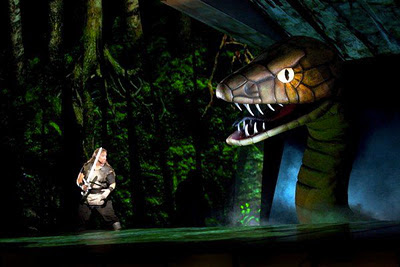Wrapping up the Met Season
I wrote a lot of stuff this year about the 2011-2012 Metropolitan Opera season. From previews of every production to reviews of almost every show, the big house on W. 64th St. gets a lot of coverage on this blog.
The good news: this year had some exceptional revivals, including Satyagraha, The Makropulos Case and L'Elisir d'Amore.
The bad news: some new productions that ranged from decent (Anna Bolena) to disastrous. (For more on that, keep reading.)
 |
| Our hero (Jay Hunter Morris) battles Fafner (right) in Act II of Siegfried. Photo by Ken Howard © 2011 The Metropolitan Opera. |
The good news: this year had some exceptional revivals, including Satyagraha, The Makropulos Case and L'Elisir d'Amore.
The bad news: some new productions that ranged from decent (Anna Bolena) to disastrous. (For more on that, keep reading.)
The season's over and it's time to highlight the good and the bad of this season which saw the completion of the Robert Lepage Ring, the launch of several exciting new productions, and two, (count 'em, two!) premieres starring Anna Netrebko. All links will lead to Superconductor reviews of the operas in question.
THE BEST:
The Big Meanie: Hans-Peter König in the Ring.
The Big Meanie: Hans-Peter König in the Ring.
In a series of Wagner performances undercut by questionable casting decisions, Mr. König stood out in bass roles in each of the four operas. The bearish German singer was particularly memorable as Hagen in Götterdämmerung.
The Alternate Ending: Khovanshchina
It was a welcome surprise to see Mussorgsky's unfinished opera on the schedule this season. More surprising: conductor Kirill Petrenko choosing the eerie Act V orchestration by Igor Stravinsky. (It had never been performed at the Met.) Mention must also be made of Olga Borodina's show-stealing performance as Marfa.
The Ladies Man: Gerald Finley in Don Giovanni
For a man with an active social calendar, Michael Grandage's new production of the Don was tough to love. The standout was Mr. Finley, leading the second cast of the opera in February. Whether he was paired with Kyle Ketelsen in February or Bryn Terfel in March, Mr. Finley took an engaging and surprisingly funny turn as the Don.
The Surprise: Malin Byström in Faust.
Another case of the second cast upstaging than the first. Swedish soprano Malina Byström was perfectly paired with Roberto Alagna's Faust in December performances of Des McAnuff's new production of the Gounod chestnut. That didn't prevent this production (which suffered from a painfully forced update to the atomic age) from bombing with opera lovers.
The Slam Dunk: Angela Meade in Ernani.
Ms. Meade has become a popular figure with opera cognoscenti, for her fluted, round spinto. This American soprano has an old-fashioned star quality that is sometimes missing from singers of lesser presence. In other words, she sings real purdy. Her presence was the best thing about the February revival of this Verdi opera.
THE WORST:
Cardboard Hero: Jay Hunter Morris in Götterdämmerung.
Mr. Morris made a stellar impression in Siegfried but when it came to the heavier opera, he ran into trouble. He gets credit for playing the drugged Siegfried as even more of an idiot than usual. However, the singer's decision to remain tacet instead of attempting the difficult octave drop on "Meinem frohen Mute" in Act II demotes him to the level of cardboard hero.
A Torment to the English language: The Enchanted Island.
Jeremy Sams' baroque mash-up attempted to cross-pollinate the lovers from Shakespeare's A Midsummer Night's Dream onto the rock ruled by Prospero (David Daniels) in The Tempest. Although the opera featured some sterling singing and clever use of music by Handel, Vivaldi and Telemann, Mr. Sams' book used expressions like "whee" and "okay." That ain't exactly Shakespeare.
A Slave Screams: Opening night of Aida.
Even more dagerous than the threat of invading Ethiopians was Violeta Urmana's initial outing in the title role of Verdi's grandest opera. A disastrous Nile Scene (with multiple high notes pulled sharp above the stave) led to Ms. Urmana's illness and eventual replacement: first by Sondra Radnavovsky, then by Latonia Moore for the broadcast.
Fabulous Disaster: The new Manon.
This poor man's staging of the Massenet opera (imported from the English National Opera) takes the proverbial taco for worst new production. The prison courtyard--excuse me, inn courtyard--looked better suited to Fidelio. In Act III, the ramps onstage made it look as if the Met were trying to compensate for the house's lack of facilities for the disabled. Worst of all, the periodic interruptions in the Act IV casino scene with wheeled gaming tables sliding on and off the stage like hospital gurneys. Ugh.
"A Snake! A Snake!" The dragon in Siegfried.
As this list began, it ends with the Lepage Ring. This new staging has some inspired imagery but is marred by visual mistakes. Some of them (like the popping plaster statue heads at the end of Götterdämmerung) have been revised. The worst remains: a gigantic, goofy-looking snake that poses as much threat as a Macy's balloon, standing in for Fafner the dragon in Act II of Siegfried. When I proposed on this site (last year) that the Bronx Zoo Cobra should play the cave-dwelling beastie in this opera, I WAS KIDDING!




